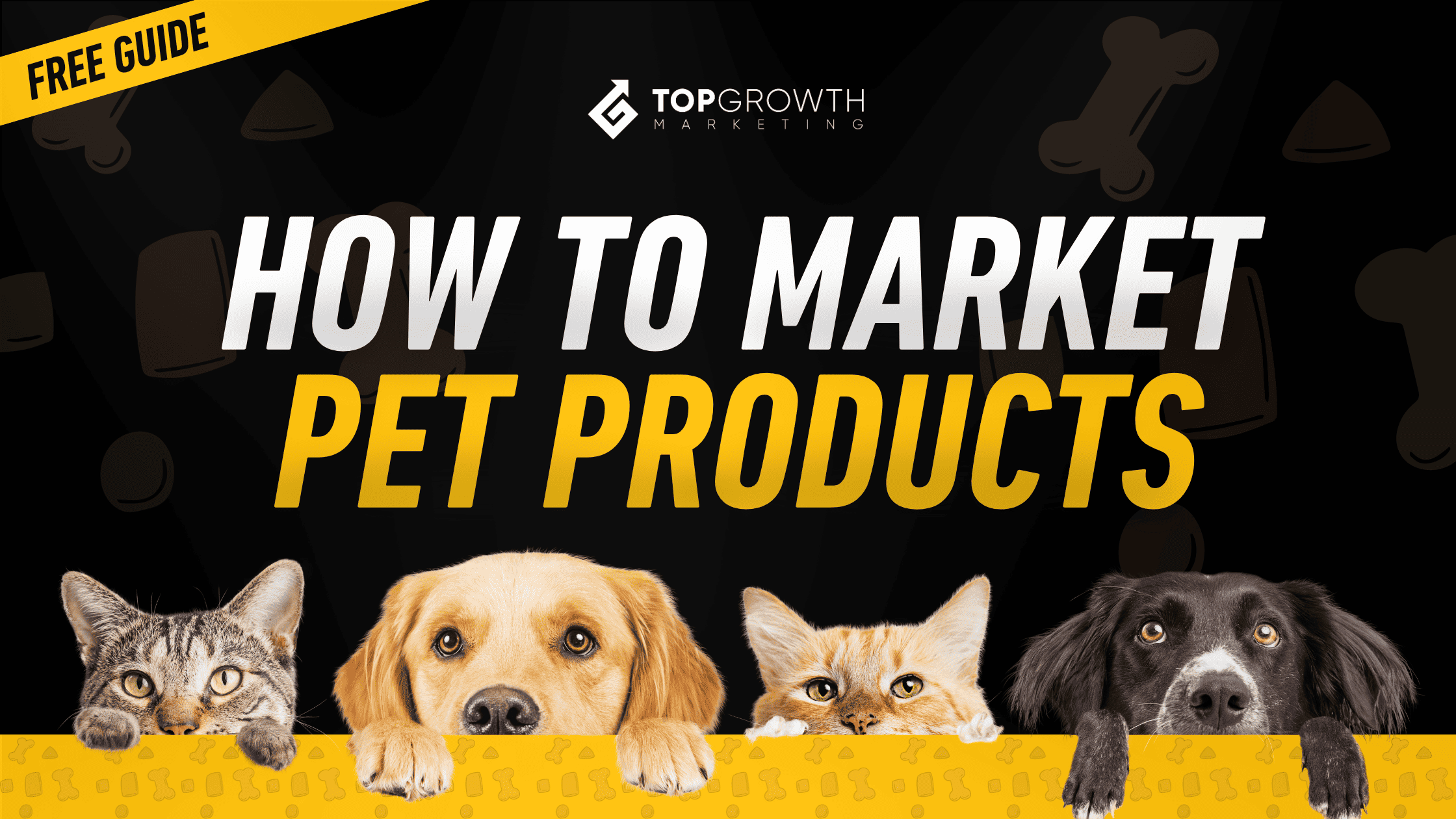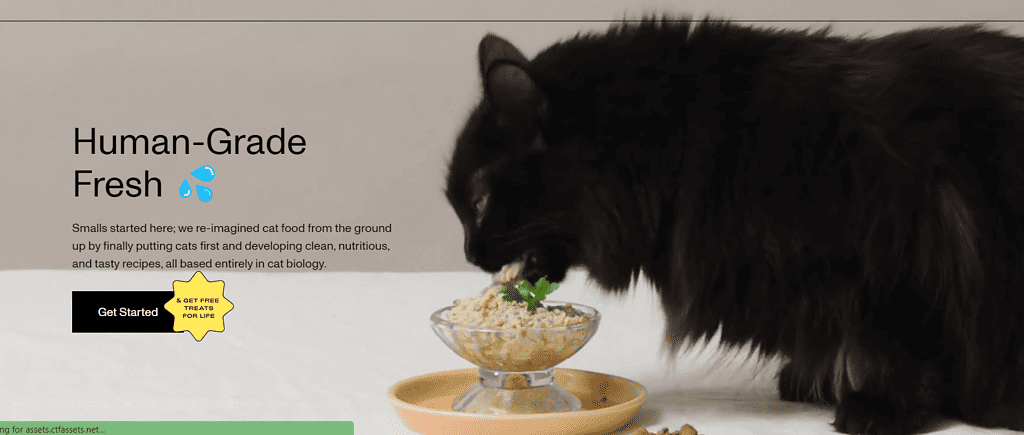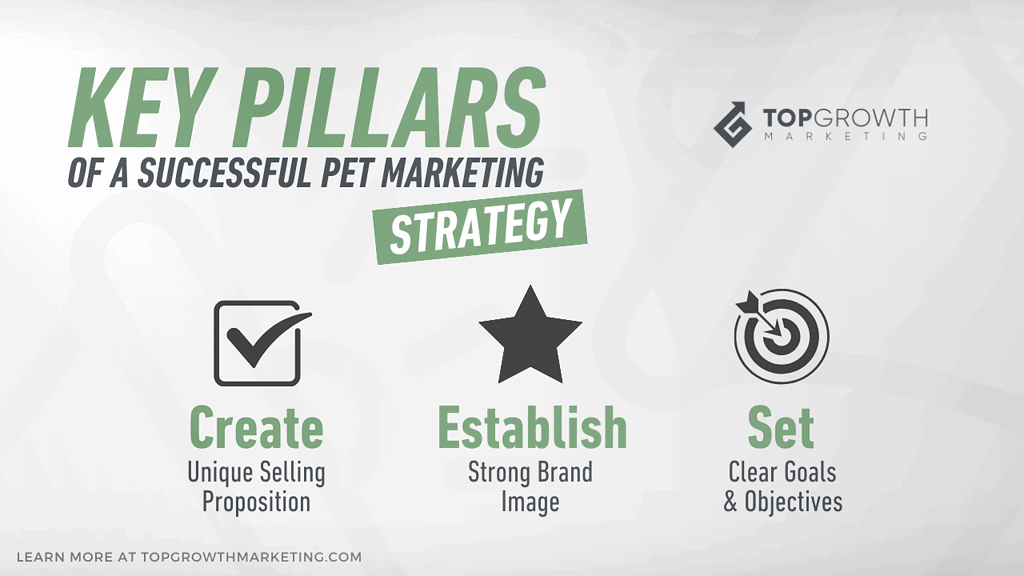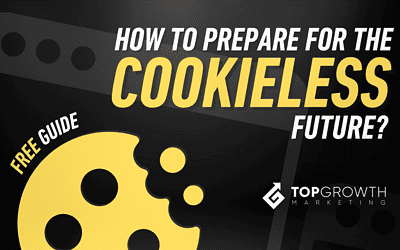Pet brands, you’re lucky.
In a market where 67% of U.S. households own a pet, the pet industry has become a vital part of the American economy, expecting it to grow about 5% per year through 2030.
Successful pet training businesses don’t just happen—they’re a result of astute marketing strategies that know how to navigate this growth. We’ve had the good fortune to work with many major pet brands and learn the most effective tactics and strategies to reach pet owners.
Pet brand marketing has become one of our specializations as an agency and we’re very passionate pet owners as well.
In this guide, we’re sharing everything we’ve learned so you, too, can build and grow a successful pet brand.
Understanding Your Audience
At the heart of any thriving pet brand is a deep understanding of the pet owner’s psyche. This should come easily because either you or someone you know is likely a per owner.
That said, pet owners are not a monolith; they are as diverse as the pets they care for. However, certain spending habits and emotional triggers are common across this broad spectrum.
Analyzing Pet Owners’ Spending Habits
Recent studies reveal that pet owners are increasingly investing in health and wellness products, eco-friendly items, and tech gadgets that enhance the pet care experience.
They prioritize value but are willing to pay a premium for products that promise added benefits for their pet’s health and happiness.
For instance, a brand like Smalls can avoid competing on price almost entirely by creating premium human-grade cat food.
What does that mean for you? Well, for one, it means that a lot of pet products are slowly inching into the category of luxury goods and you can price them accordingly.
Identifying Pet Parent Emotions in Purchase Decisions
The emotional bond between pet owners and their pets is, from a marketing standpoint, similar to that between parents and children.
This bond is the silent salesman in the pet industry. Whether it’s the security offered by a GPS-enabled collar or the joy of a new interactive toy, pet owners frequently make purchases driven by the desire to provide the best for their furry friends.
The takeaway is this: craft your messaging around what the product does for the pet. Not the owner. Pet owners are happy when their pets are happy.
Importance of Understanding Pet Owners’ Needs and Preferences
To truly connect with pet owners, brands must grasp their unique needs and preferences. This means engaging in ongoing dialogue through social media, surveys, and community events.
It also involves looking out for trends and adapting to changes in consumer behavior.
Brands that listen and respond to the needs of pet owners cultivate loyalty and trust, which is the bedrock of any successful pet brand.
For instance, given that pet wellness is on the rise, you can be pretty confident that vet visits are going to increase. Brands like Wagmo are already listening to that need by providing comprehensive pet health insurance.
Developing a Pet Product Marketing Strategy
The next part of your marketing plan should be to create a broad marketing strategy. Once you have your target audience in mind, it’s time to start figuring out how your products fit into their life and their pets’ lives.
Creating a Unique Selling Proposition for Pet Products
Your unique selling proposition (USP) is the linchpin of your marketing strategy. It defines what sets your pet products apart from the competition.
Whether it’s an innovative design, organic materials, or a charitable partnership, your USP should resonate with your target market’s values and needs, providing a compelling reason why they should choose your brand.
Think about filling in this blank:
My brand does ________ better than any other brand. That’s your USP.
😎🐕 Pet brands are increasingly finding success by placing themselves as lifestyle brands. That’s a bold choice, but if you commit to it, you can make it work in your messaging and content.
Establishing a Strong Brand Image in the Market
A strong brand image is vital for customer recognition and loyalty. It encompasses your visual identity, brand voice, and the emotions you want to evoke in your customers.
Consistency across all platforms and communications is crucial, as it builds trust and reliability in the eyes of pet owners.
It’s a lot of work because you’ll need to genuinely understand what drives your customers and create content around that. But the results are worth it.
Don’t overlook the power of Digital PR in boosting your brand’s trust. It’s not just about being seen; it’s about being seen in the right places.
Get your articles on pet care and your brand’s story published on reputable pet blogs and industry websites. This builds credibility with both readers and search engines without sounding like a sales pitch.
Setting Clear Marketing Goals and Objectives
Concrete goals and objectives provide direction for your marketing efforts and a way to measure success.
You don’t need to make these too specific. And you don’t want to fall into the trap of making them complicated for the sake of complexity.
Take the tried and true approach.
Your goals should be SMART: Specific, Measurable, Achievable, Relevant, and Time-bound.
Whether you aim to increase brand awareness, boost online sales, or grow your social media following, having clear targets helps you focus your resources and track your progress.
eCommerce Store Marketing For Pet Brands
Next up, it’s worth touching on the basics of setting yourself up for eComm success. Branding and high-level strategy are pivotal, but getting customers to visit your store and make purchases is where the rubber really meets the road.
Optimizing the Online Store for Better Visibility and User Experience
Your store has one simple goal: turn visitors into customers. Every decision you make about how it looks and performs should be subordinate to that goal.
That means giving customers everything they need to make a purchasing decision at a glance and then making it easy to finalize the purchase.
For instance, pet food products should have detailed nutritional information readily accessible.
Look at Chewy’s product pages and how they help owners ensure they’re meeting their pet’s dietary needs.
See the emphasis on taste and that it contains real meat? Now check this:
Moreover, embodying the warmth and affection pet owners feel for their animals, just like Downtown Pet Supply, with a welcoming homepage can establish an immediate emotional connection.
There are plenty of other simple and easy tactics to make your store appealing to pet owners. Taking your cue from other successful pet brands’ best design features is a great place to start.
Implementing Effective SEO Strategies for Pet Product Visibility
Placing your brand on many distribution channels is certainly a great way to scale, whether that’s Amazon, Instagram Shopping, or any other.
However, using your own web property will always be more profitable in the long run. That’s why SEO has to be baked into your business from the start.
Even if you mainly rely on sales from advertising, a vital and thriving site will be your best source of audience insights.
You don’t need to spend months learning every SEO technique and “secret”. Only two things matter in SEO: the right content and the right links.
To get the content right, use naming conventions in your products that match how your audience searches. If someone is looking for ‘hypoallergenic meat for dogs’, don’t try to convince that searcher that no meat is inherently less allergenic than any other.
Give them what they want by creating a page named Hypoallergenic Dog Food.
For links, your main approach should be to consistently and persistently release shareable and remarkable content.
Now, you’re not always going to have something spectacular to say or share but as long as you’re putting in the effort, it will pay off with a few links here and there that add up in the long run.
That’s about it. That’s the foundation of any good SEO strategy, the rest are details.
Leveraging Email Marketing Campaigns for Customer Retention
Emails are your brand’s best friend for keeping customers close. Start with a warm welcome email and keep the conversation going.
Personalize your messages to match the pet parent’s journey — from the first toy purchase to celebrating their pet’s birthday. It’s these thoughtful touches that turn a one-time buyer into a lifelong customer.
It’s about engaging customers beyond the checkout page, providing them with a stream of value that nurtures the relationship.
Initiate this by segmenting your audience and tailoring content to their pets’ life stages, needs, and your product’s lifecycle.
For example, offering a puppy training guide post-purchase of a chew toy or a seasonal pet safety checklist can fortify customer relationships and increase lifetime value.
Moreover, a well-structured email marketing strategy employs behavioral triggers from customer interactions on your site. Whether it’s a follow-up on an abandoned cart or a personalized birthday discount, these touches can significantly enhance customer retention rates.
Email marketing, like all other aspects of digital marketing, is always evolving. Make a habit of keeping up with email marketing trends every so often to make sure you’re leveraging it to its full potential.
Remember, the goal is to make every recipient feel like part of a community, not just a transaction.
This approach doesn’t just sell products; it builds a pet-loving family, echoing the community essence that’s at the heart of every pet owner’s journey.
Leveraging Social Media Marketing
Social media isn’t just a tool; it’s the digital playground for pet lovers. Use it to splash your brand across the web with engaging posts that pet parents can’t resist sharing.
And don’t stop there — team up with influencers whose furry friends can showcase your products authentically. It’s like having a trusted pet-lover whisper your brand’s name in just the right ears
We won’t go too deeply into media buying and ad writing strategy here, but here is how you’re going to build your social media marketing foundation.
Sama as with SEO, the very basic thing you need to do is simply express your brand genuinely on your social media channels – consistently and persistently. The single biggest predictor of your success is how consistently you put out content that engages viewers.
Engaging Content that Gets Tails Wagging
The key to a successful social media presence is engaging content. This could range from pictures of pets enjoying your products to educational posts that help pet parents care better for their furry friends.
Use content to tap into the emotional bond between pets and their owners, much like Pedigree did with their #FeedTheStrays campaign during the pandemic.
Product Placement: Showcasing Products in Action
Use social media to demonstrate how your products work in real life.
Share videos of pets using your products. This is a great way to show how your products can benefit pets and their owners. Here are some ideas for videos:
- A dog playing fetch with a new toy.
- A cat relaxing in a new bed.
- A rabbit enjoying a new treat.
Share photos of pets with your products. This is another great way to show how your products can be incorporated into the lives of pets and their owners. Here are some ideas for creative marketing imagery:
- A dog looking proud in a new collar.
- A cat grooms itself with a new brush.
- A rabbit eating from a shiny new food bowl.
You can also use social media to showcase your products in more creative ways. For example, you could create a GIF of a dog wagging its tail after eating a new treat, or you could share a comic strip about a pet using your product.
Measuring Success with Analytics
Lastly, to ensure your social media efforts are not just a wild goose chase, utilize analytics tools to track engagement, reach, and conversion. These insights will help you refine your strategies and invest more in the types of content that lead to the best engagement and ROI.
Always make decisions based on data. Even a little bit of data to back up your decisions will make a huge difference to their success rate.
Influencer Marketing Campaigns
The last big aspect of pet brand marketing we’re going to touch on is influencer marketing. It’s typically lumped in with social media marketing but we think it’s important enough to merit its own section.
Selecting the Right Influencer
The synergy between a pet brand and an influencer’s principles is not just beneficial; it’s imperative.
The right influencer embodies your brand’s spirit and conveys your message with an authenticity that resonates deeply with their followers.
Just as a well-trained pup reflects its owner’s care, an influencer must genuinely connect with your ethos, creating content that’s not only engaging but also faithful to your brand’s identity.
When selecting the right influencer for your pet brand, consider these actionable and practical guidelines:
Scrutinize potential conflicts ensuring past partnerships don’t muddy the authenticity of the message. It’s like choosing the perfect breed for your lifestyle; the right fit is paramount for a harmonious relationship.
Alignment with Brand Values: Ensure the influencer’s values and content align with your brand’s ethos. This includes their stance on pet care, nutrition, and welfare issues that your brand cares about.
Authentic Connection: Look for influencers who have a genuine connection with their pet and their audience. Their authentic interactions and content will reflect on your brand.
Audience Relevance: The influencer’s audience should overlap with your target market. Analyze their followers to ensure they match your customer demographics.
Building a Relationship with Influencers
Once you’ve found a few influencers that seem to be a good fit, you’ll want to nurture those relationships.
The real benefits of influencer relationships will materialize with time. If an influencer endorses your brand once, it can come off as a simple marketing sponsorship. Over time, though, the influencer’s audience will begin to see your brand as a trusted part of that influencer’s life.
Approach influencers as partners in a journey towards mutual growth, not just as a means to an end.
Communicate your brand’s story and listen to their insights, fostering a bond that goes beyond mere transactions.
This partnership should be a two-way street, offering value to both parties. A successful collaboration is built on a foundation of clear expectations and shared goals, much like the trust established between a pet and its owner through consistent training and positive reinforcement.
Collaboration Strategies With Influencers
Strategic collaboration with influencers requires the same attention to detail as designing a new product line.
Plan content that showcases your products in action, integrating seamlessly into the influencer’s narrative.
It’s crucial to establish a clear communication channel and set precise expectations, just as you would when setting up a training routine for a new puppy.
Whether it’s through co-created content or cross-promotion, each step should be aligned with the overarching marketing strategy, ensuring that both the influencer and the brand move together in tandem towards shared objectives.
Here are some ideas to get you started:
Co-Creation: Work with influencers to co-create content that feels natural to their style while also highlighting your brand’s message. This could be a series of branded posts or stories that the influencer helps to design.
Exclusive Access: Provide influencers with early or exclusive access to new products. This can generate excitement and exclusive content that their audience, and yours, will value.
Takeovers: Arrange for influencers to take over your brand’s social media accounts for a day or a set period, bringing their unique style and audience to your platform.
Brand Ambassadorships: Develop long-term relationships with influencers who can act as brand ambassadors. This strategy often involves a series of campaigns or a consistent brand presence in the influencer’s content.
Conclusion – Pet Brand Marketing is Hard Work
As the pet industry continues to expand, the strategies outlined in this guide offer a roadmap for pet brands to navigate the competitive landscape and connect with their audience.
From understanding pet owner behaviors to optimizing online experiences, and embracing the power of influencer partnerships, each aspect contributes to a comprehensive marketing approach.
Success lies in genuine connections—whether it’s through shared values, impactful content, or collaborative relationships.














0 Comments